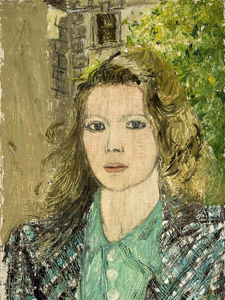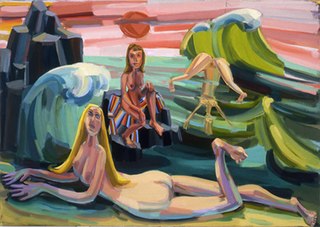Related Research Articles

Eleanor Antin is an American performance artist, film-maker, installation artist, conceptual artist, feminist artist, and university professor.

Carolee Schneemann was an American visual experimental artist, known for her multi-media works on the body, narrative, sexuality and gender. She received a B.A. in poetry and philosophy from Bard College and a Master of Fine Arts from the University of Illinois. Originally a painter in the Abstract Expressionist tradition, Schneeman was uninterested in the masculine heroism of New York painters of the time and turned to performance-based work, primarily characterized by research into visual traditions, taboos, and the body of the individual in relation to social bodies. Although renowned for her work in performance and other media, Schneemann began her career as a painter, saying: "I'm a painter. I'm still a painter and I will die a painter. Everything that I have developed has to do with extending visual principles off the canvas." Her works have been shown at the Los Angeles Museum of Contemporary Art, the Museum of Modern Art in New York, the London National Film Theatre, and many other venues.

A.I.R. Gallery is the first all female artists cooperative gallery in the United States. It was founded in 1972 with the objective of providing a professional and permanent exhibition space for women artists during a time in which the works shown at commercial galleries in New York City were almost exclusively by male artists. A.I.R. is a not-for-profit, self-underwritten arts organization, with a board of directors made up of its New York based artists. The gallery was originally located in SoHo at 97 Wooster Street, and was located on 111 Front Street in the DUMBO neighborhood of Brooklyn until 2015. In May 2015, A.I.R. Gallery moved to its current location at 155 Plymouth St, Brooklyn, NY 11201.

Sylvia Sleigh was a Welsh-born naturalised American realist painter who lived and worked in New York City. She is known for her role in the feminist art movement and especially for reversing traditional gender roles in her paintings of nude men, often using conventional female poses from historical paintings by male artists like Diego Vélazquez, Titian, and Jean-Auguste-Dominique Ingres. Her most well-known subjects were art critics, feminist artists, and her husband, Lawrence Alloway.

Feminist art is a category of art associated with the feminist movement of the late 1960s and 1970s. Feminist art highlights the societal and political differences women experience in their lives. The goal of this art form is to bring a positive and understanding change to the world, leading to equality or liberation. Media used range from traditional art forms, such as painting, to more unorthodox methods such as performance art, conceptual art, body art, craftivism, video, film, and fiber art. Feminist art has served as an innovative driving force toward expanding the definition of art by incorporating new media and a new perspective.
Marilyn Minter is an American visual artist who is perhaps best known for her sensual paintings and photographs done in the photorealism style that blur the line between commercial and fine art. Minter currently teaches in the MFA department at the School of Visual Arts in New York City.
Idelle Lois Weber was an American artist most closely aligned with the Pop art and Photorealist movements.
Deborah Kass is an American artist whose work explores the intersection of pop culture, art history, and the construction of self. Deborah Kass works in mixed media, and is most recognized for her paintings, prints, photography, sculptures and neon lighting installations. Kass's early work mimics and reworks signature styles of iconic male artists of the 20th century including Frank Stella, Andy Warhol, Jackson Pollock, and Ed Ruscha. Kass's technique of appropriation is a critical commentary on the intersection of social power relations, identity politics, and the historically dominant position of male artists in the art world.

Miriam Schapiro was a Canadian-born artist based in the United States. She was a painter, sculptor, printmaker, and a pioneer of feminist art. She was also considered a leader of the Pattern and Decoration art movement. Schapiro's artwork blurs the line between fine art and craft. She incorporated craft elements into her paintings due to their association with women and femininity. Schapiro's work touches on the issue of feminism and art: especially in the aspect of feminism in relation to abstract art. Schapiro honed in her domesticated craft work and was able to create work that stood amongst the rest of the high art. These works represent Schapiro's identity as an artist working in the center of contemporary abstraction and simultaneously as a feminist being challenged to represent women's "consciousness" through imagery. She often used icons that are associated with women, such as hearts, floral decorations, geometric patterns, and the color pink. In the 1970s she made the hand fan, a typically small woman's object, heroic by painting it six feet by twelve feet. "The fan-shaped canvas, a powerful icon, gave Schapiro the opportunity to experiment … Out of this emerged a surface of textured coloristic complexity and opulence that formed the basis of her new personal style. The kimono, fans, houses, and hearts were the form into which she repeatedly poured her feelings and desires, her anxieties, and hopes".
Martha Wilson is an American feminist performance artist and the founding director of Franklin Furnace Archive art organization. Over the past four decades she has developed and "created innovative photographic and video works that explore her female subjectivity through role-playing, costume transformation, and 'invasions' of other peoples personas". She is a recipient of two National Endowment for the Arts fellowships, a New York Foundation for the Arts fellowship, and an Obie Award and a Bessie Award for commitment to artists’ freedom of expression. She is represented by P.P.O.W. Gallery in New York City.

Howardena Pindell is an American artist, curator, critic, and educator. She is known as a painter and mixed media artist who uses a wide variety of techniques and materials. She began her long arts career working with the New York Museum of Modern Art, while making work at night. She co-founded the A.I.R. gallery and worked with other groups to advocate for herself and other female artists, Black women in particular. Her work explores texture, color, structures, and the process of making art; it is often political, addressing the intersecting issues of racism, feminism, violence, slavery, and exploitation. She has created abstract paintings, collages, "video drawings," and "process art" and has exhibited around the world.
Harmony Hammond is an American artist, activist, curator, and writer. She was a prominent figure in the founding of the feminist art movement in 1970s New York.
Anita Slavin Arkin Steckel was an American feminist artist known for paintings and photomontages with sexual imagery. She was also the founder of the arts organization "The Fight Censorship Group", whose other members included Hannah Wilke, Louise Bourgeois, Judith Bernstein, Martha Edelheit, Eunice Golden, Juanita McNeely, Barbara Nessim, Anne Sharpe and Joan Semmel.
Nina Kuo is an Asian American painter, photographer, sculptor, author, video artist and activist who lives and works in New York City. Her work examines the role of women, feminism and identity in Asian-American art. Kuo has worked in partnership with the artist Lorin Roser. Kuo has been described as being a pioneer of AAPI and Chinese American art and culture.
Judith Bernstein is a New York artist best known for her phallic drawings and paintings. Bernstein uses her art as a vehicle for her outspoken feminist and anti-war activism, provocatively drawing psychological links between the two. Her best-known work features her iconic motif of an anthropomorphized screw, which has become the basis for a number of allegories and visual puns. During the beginning of the Feminist Art Movement, Bernstein was a founding member of the all-women's cooperative A.I.R. Gallery in New York.

Ann Agee is an American visual artist whose practice centers on ceramic figurines, objects and installations, hand-painted wallpaper drawings, and sprawling exhibitions that merge installation art, domestic environment and showroom. Her art celebrates everyday objects and experiences, decorative and utilitarian arts, and the dignity of work and craftsmanship, engaging issues involving gender, labor and fine art with a subversive, feminist stance. Agee's work fits within a multi-decade shift in American art in which ceramics and considerations of craft and domestic life rose from relegation to second-class status to recognition as "serious" art. She first received critical attention in the influential and divisive "Bad Girls" exhibition, curated by Marcia Tucker at the New Museum in 1994, where she installed a functional, handmade ceramic bathroom, rendered in the classic blue-and-white style of Delftware. Art in America critic Lilly Wei describes Agee's later work as "the mischievous, wonderfully misbegotten offspring of sculpture, painting, objet d'art, and kitschy souvenir."
Kathe Burkhart is an American interdisciplinary artist, painter, writer and art critic. Described as both a conceptual artist and an installation artist, she uses various media in her work, combining collage, digital media, drawing, fiction, installation, nonfiction, painting, photography video, poetry, and sculpture. The content is feminist; the radical female is the subject. The Liz Taylor painting series, which she began painting in 1982, have been exhibited at the MoMA PS1, the Stedelijk Museum, and the Venice Biennale. Burkhart is also the author of literary fiction and poetry.

Judith Linhares is an American painter, known for her vibrant, expressive figurative and narrative paintings. She came of age and gained recognition in the Bay Area culture of the 1960s and 1970s and has been based in New York City since 1980. Curator Marcia Tucker featured her in the influential New Museum show, "'Bad' Painting" (1978), and in the 1984 Venice Biennale show, "Paradise Lost/Paradise Regained: American Visions of the New Decade." Linhares synthesizes influences including Expressionism, Bay Area Figuration, Mexican modern art and second-wave feminism, in work that flirts with abstraction and balances visionary personal imagery, expressive intensity, and pictorial rigor. Art historian Whitney Chadwick wrote, "Linhares is an artist for whom painting has always mattered as the surest path of synthesizing experience and interior life," her works "emerging as if by magic from an alchemical stew of vivid complementary hues and muted tonalities." Critic John Yau describes her paintings "funny, strange, and disconcerting," while writer Susan Morgan called them "unexpected and indelible" images exploring "an oddly sublime territory where exuberant bliss remains inseparable from ominous danger."
Katie Vida is an American interdisciplinary artist, curator and arts educator based in Brooklyn, New York. She is best known for her performance art, installation art, film, and sound art but also known to create paintings and sculptures.

Katharine Kuharic is an American artist known for multi-layered representational paintings that combine allegory, humor, social critique, and aspects of Pop and pastoral art. Her art typically employs painstaking brushwork, high-keyed, almost hallucinogenic color, discontinuities of scale, and compositions packed with a profusion of hyper-real detail, figures and associations. She has investigated themes including queer sexual and political identity, American excess and suburban culture, social mores, the body and death. Artist-critic David Humphrey called Kuharic "a visionary misuser" who reconfigures disparate elements into a "Queer Populist Hallucinatory Realism" of socially charged image-sentences that shake out ideologies from "the congealed facts of contemporary culture" and celebrate the possibility of an alternative order.
References
- 1 2 3 4 "Biography: Dotty Attie". P.P.O.W. Gallery. Retrieved November 4, 2014.
- 1 2 3 "Dotty Attie: Biography". Brooklyn Museum. Retrieved May 20, 2013.
- ↑ "National Academicians". National Academy. Archived from the original on November 9, 2014. Retrieved December 3, 2014.
- ↑ Great women artists. Phaidon Press. 2019. p. 42. ISBN 978-0714878775.
- 1 2 3 4 5 Park, Rebecca (12 August 2010). "SOLO Spotlight: Dotty Attie". Broad Strokes: NMWA'S Blog for the 21st Century. National Museum of Women in the Arts. Retrieved May 20, 2013.
- ↑ "Dottie Attie" . Retrieved March 1, 2018.
- 1 2 3 4 5 6 7 "The First Act: An Archaeological Adventure from J. and Armand Tour the World," Wadsworth Atheneum, January 1, 1980.
- ↑ Cooper, Ashton. "18 Questions for Mask-Obsessed Painter Dotty Attie". Blouin Art Info. Lousie Blouin Media. Archived from the original on 11 November 2017. Retrieved 13 March 2015.
- 1 2 "Elizabeth A. Sackler Center for Feminist Art: Feminist Art Base: Dotty Attie" . Retrieved October 10, 2014.
- 1 2 3 4 "History". A.I.R. Gallery. Archived from the original on July 15, 2014. Retrieved July 21, 2014.
- ↑ Swartz, Anne K. "A.I.R. Gallery." In The Grove Encyclopedia of American Art, edited by Joan M. Marter. Oxford: Oxford University Press, 2011.
- ↑ Jewish Women's Archive: "Art in the United States" by Gannit Ankori and Ziva Amishai-Maisels retrieved December 9, 2014
- 1 2 3 Lovelace, Carey. "Aloft in Mid A.I.R." Archived from the original on July 15, 2014. Retrieved November 4, 2014.
- ↑ "SOLO Spotlight: Dotty Attie". Broad Strokes: The National Museum of Women in the Arts' Blog. 2010-08-12. Retrieved 2017-11-11.
- ↑ "This Will Have Been: Art, Love & Politics in the 1980s". Museum of Contemporary Art, Chicago. Archived from the original on January 16, 2014. Retrieved May 21, 2013.
- ↑ Bell, Tiffany. "Dotty Attie." Arts Magazine (January 1, 1979): 5.
- ↑ Sackler, Elizabeth. "Center for Feminist Art Base: Dotty Attie". Brooklyn Museum. Retrieved 6 March 2015.
- 1 2 3 Wilson, Aimee. "Dotty Attie, Behind the Mask." Art in America (November 18, 2013).
- ↑ Symonds, Alexandria (November 20, 2013). "Ranger Games".
- ↑ Cooper, Ashton. "18 Questions for Mask-Obsesed Painter Dotty Attie". Blouin Art Info. Louise Blouin Media. Archived from the original on 11 November 2017. Retrieved 13 March 2015.
- ↑ "Dottie Attie" . Retrieved December 3, 2014.
- ↑ "RANGER GAMES: DOTTY X ELI ATTIE". 22 November 2013. Archived from the original on 2013-11-26. Retrieved Nov 1, 2019.